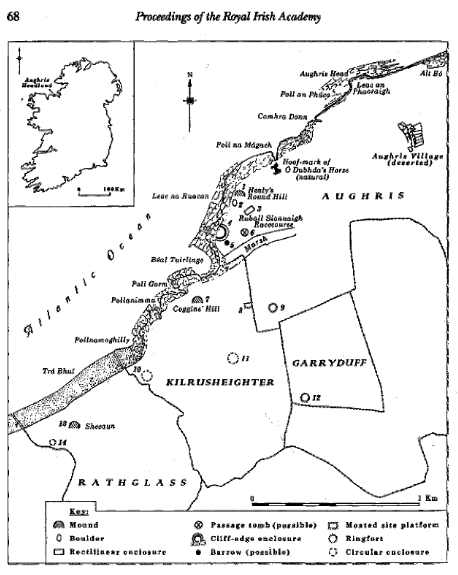Significant Heritage Site at Aughris
Edited by Padraic Feehily
Aughris headland is a prominent feature of the North Connacht coastline forming the most south-westerly point of Sligo Bay. There is a sense of this place as a private country perfectly circumscribed by its geography. The headland is characterised by coastal cliffs and sandhills, gently rolling pastureland and marsh.

Perhaps because of its relative seclusion Aughris escaped the attentions of travel writers and antiquaries of the eighteenth and nineteenth century. Coquebert de Montbret, the French writer travelling through the area in 1791 did not venture onto the headland but stayed at the only inn on the route (Corhaghmore or Curraghmore). Unimpressed by the amenities of this “Isolated cabin”, he recalled lodging with the animals like Noah in his ark. Surprisingly the Ordinance Survey of 1838 paid only cursory attention to the antiquities of this sequestered country. It is perhaps an accident of the geography and history of Aughris, that the remarkable archaeology is so poorly documented. The place names and its recorded folklore remain the only means to understanding the field monuments.
A Royal Irish Academy study of 2001 suggests evidence for modern popular gathering on Aughris and attempts to define the landscape where medieval, royal assembly may have taken place. The study limits are the townlands of Garyduff, Kilrusheighter and Rathglass. It is proposed the “Coggins Hill” in Kilrusheighter is possibly the hitherto unidentified post-Norman inauguration site of the Uí Dhubhda chiefs of Tir Fhiachrach. The possibility is also raised that “Healys Round Hill”north of Kilrusheighter on the west side of Aughris headland may have constituted the site of an early medieval óenach (tribal assembly). This claim does not have the support of historical documentation. It relies on the testimony of folklore. The recurrent use of the headland for modern assembly and the survival of earthwork monuments of unusual character on the western side of the headland. Non-archaeological evidence includes late Lughnasa celebrations, allusions to horses and horse racing and the use of the headland for political gatherings and feiseanna in the modern period, sympathetic place-names and anecdotes cites as late as the 1930s.
A case for an óenach can be tentatively constructed from the combined bits of place-names, folklore and archaeological record. If Aughris was a gathering place for the Kings of Tir Fhiachrach in the pre-Norman period, the headland may have been the choice of a new and regular inauguration venue for the Uí Dhubhda lords after they expelled the Anglo-Norman de Bermingham in the fourteenth century.
In her account of the celebration of the festival of Lughnasa at Aughris, Maire Mac Neill commented that “local tradition had preserved not only the memory of the rural festivity of recent centuries but also in the fragmenting legendary beliefs, a suggestion of ancient significance and importance.” The lore referred to the celebrations of a patrún (festival) on the last Sunday of July variously recorded as Garland Sunday, Garlic Sunday, Aughris Sunday and the Sunday of the New Potatoes. People from the borough of Tireragh and Leyny attended. The day included the picking of “hurds” along the cliffs, matchmaking, the performance of the rounds of St Patrick’s Well and dancing, singing and games around the old fort. Conversations with the elderly folks in the 1960s suggest the festivities were held in the later period in Finnegan’s Field by the pier and ended about 1954.
In the early part of the twentieth century the Templeboy Races were held at Aughris Head and later transferred to Dunmoran Strand to the east of the headland. Races were held in the 1920s and 1930s on a stretch of land called Ruball Sionnagh in the southwest corner of Aughris townland. Aughris from the Irish “eachros” translates as “horse headland”. Dr Nollaig O’Muráile points out that the Irish form of this place name represents a name structure that predates the seventh century and could have pre-Christian origins.
Aside from Lughnasa celebrations, Aughris was a frequent venue for political meetings generally held on the traditional Lughnasa festival assembly day. Held here was Parnell’s assembly of 1890 and an Irish Language Movement rally attended by some 8000 people and addressed by Douglas Hyde and JP Henry held on Garland Sunday, 27th July 1901. Political assembly is also celebrated in local song, like John Gilmore’s nineteenth century ballad “Leyny Boys”
“As we marched down Ladies Brae we viewed Tireragh’s shore
And the ships out in the ocean came towing to the shore.
They assembled there in thousands from Sligo to Knochnarea”
There are several examples of monster political gatherings around the country held at similar hallowed sites. Whether Tara or Aughris, it could conceivably indicate a persistence of ancient memory.
Following the recovery of Tir Fhiachrach by the Uí Dhubhda in the second half of the fourteenth century after 120 years of de Bermingham occupation a regular inauguration venue for the royal candidates of the sept (tribe) would have been established. The Uí Fhiachrach tract compiled by Giolla Iosa Mac Fir Bhisigh probably in the wake of that conquest and between the years 1397 and 1418, refers to Carn Inghine Brian at “Coggins Hill” in Kilrusheighter as possibly the hitherto unidentified post-Norman inauguration site of the Uí Dhubhda chiefs of Tir Fhiachrach.
Padraic Feehily is a local historian.
“Down Hyde Bridge” his current book is available at Sligo book shops €20
Email: padraicfeehily@gmail.com
